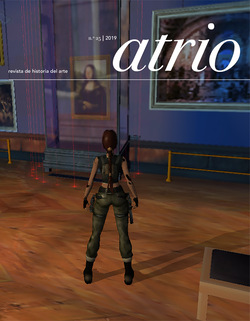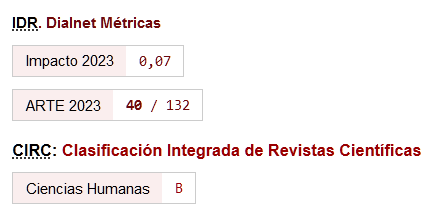¡Roba, colecciona, mira y disfruta! Museos en videojuegos
DOI:
https://doi.org/10.46661/atrio.4431Palabras clave:
museo, videojuego, expolio, humanidades digitales, Tomb Raider, Animal CrossingResumen
Lugar de misterios o poso de la memoria de un colectivo, el museo se ha convertido en el escenario perfecto para el argumento de numerosos videojuegos. Gracias a ello, usuarios de todas las edades recorren estos escenarios virtuales con más frecuencia de lo que lo hacen en la vida real, abriendo sus puertas a nuevos públicos ¿Qué imagen se da en estos medios del museo? ¿Qué expectativas generan en el jugador? En este artículo, haremos un repaso de los ejemplos más notables (como las sagas Broken Sword, Tomb Raider, Pokémon o Animal Crossing) y propondremos una categorización según sus características para estudiar posibles tendencias y entender qué percepción sobre estas instituciones podría tener el público, a raíz de la imagen que se da en esta industria de masas.
Descargas
Citas
AEVI y SIGMA DOS, Videojuegos y adultos. Madrid: AEVI, 2015.
Albarracín, Luis. “Diseñando ciudades en SimCity.” Suma+, no. 78 (2015): 65-71.
Belli, Simone, y Cristian López Raventós. “Breve historia de los videojuegos.” Athenea Digital, no. 14 (2008): 159-79.
Brown, Thomas. “The role of museums in videogames.” Playthepast, 2014. Consultado el 13 de mayo de 2019. https://www.playthepast.org/?p=4717
Bulbapedia. “Lumiose Museum.” Consultado el 9 de mayo de 2019. https://bulbapedia.bulbagarden.net
Contreras Espinosa, Ruth Sofhía. “Acercamiento a las características de los videojuegos y sus beneficios en el aprendizaje.” En Actas del II Congreso Internacional de Videojuegos y Educación (Cáceres, 1-3 de octubre de 2013), coordinado por Francisco Ignacio Revuelta Domínguez, M.ª Rosa Fernández Sánchez, M.ª Inmaculada Pedrera Rodríguez, y Jesús Valverde Berrocoso, 381-94. Madrid: Bubok Publishing, 2014.
Dennis, Meghan L. “Archaeogaming, Ethics, and Participatory Standards.” SAA Archaeological Record, no. 16-5 (2016): 29-33.
Fiorio, Maria Teresa. “Dallo studiolo alle grandi collezioni principesche.” Cap. 1 en Il museo nella storia. Dallo studiolo alla raccolta publica, 9-30. Milano: Bruno Mondadori, 2011.
Fosaluzza, Marianne. “Museum games. What video games could bring to museum education.” 2016. Consultado el 29 de septiembre de 2019. https://www.academia.edu/31109552/Museum_games_What_video_games_could_bring_to_museum_education
Goodlander, Georgina, y Michael Mansfield. “Press Start: Video Games in an Art museum.” Journal of interactive humanities volumen 1, issue 1 (2013): 37-41.
Guías Nintendo. “Guía oficial de Animal Crossing. New Leaf.” Consultado el 10 de mayo de 2019. http://www.guiasnintendo.com/0a_NINTENDO_3DS/animal_crossing_new_leaf/animal_crossing_new_leaf_sp/obrasarte.html
Jiménez Blanco, María Dolores. “Enciclopedia.” Cap. 4 en Una historia del museo en nueve conceptos, 73-98. Madrid: Cátedra, 2018.
Kaprielov, Ash. “The interview with Richard Morton.” Tomb of Ash. Consultado el 12 de mayo de 2019. https://tomb-of-ash.tumblr.com/post/148144640105/the-interview-with-richard-morton
Kent, Steven L. The ultimate history of video games: from Pong to Pokémon – the story behind the craze that touched our lives and changed the world. New York: Three Rivers Press, 2001.
Kim, Jim. “Interactivity, user-generated content and video game: an ethnographic study of Animal Crossing: Wild World.” Continuum, no. 28:3 (2014): 357-70.
Kiourt, Chairi, Anestis Koutsoudis, y Dimitris Kaelles. “Realistic Simulation of Cultural Heritage.” International Journal of Computational Methods in Heritage Science issue 1, no. 1 (2017): 10-40.
López Raventós, Cristian. “El videojuego como herramienta educativa. Posibilidades y problemáticas acerca de los serius games.” Apertura. Revista de Renovación Educativa, vol. 8, no. 1 (2016): 136-51.
Maccallum-Stewart, Esther. “‘Take That, Bitches!’ Refiguring Lara Croft in Feminist Game Narratives.” Game Studies issue 2, no. 14 (2014). http://gamestudies.org/1402/articles/maccallumstewart
McGeough, Kevin. “Heroes, Mummies and Treasure: Near Eastern Archaeology in the movies.” Near Eastern Archaeology, no. 69, 3-4, (2006): 174-85.
Monjelat, Natalia, y Laura Méndez. “Videojuegos y diversidad: construyendo una comunidad de práctica en el aula.” Revista de Educación a Distancia, no. 33 (2012). https://revistas.um.es/red/issue/view/13931
Naranjo Bejarano, Carlos. “El patrimonio japonés en ‘Pokémon’.” En Japón y “Occidente”: El patrimonio cultural como punto de encuentro, editado por Anjhara Gómez Aragón, 773-782. Sevilla: Aconcagua Libros, 2016.
Nintendo. “Datos financieros a julio de 2019.” Consultado el 10 de julio de 2019. https://www.nintendo.co.jp/ir/en/finance/software/3ds.html
Parker, Laura, y Alexander Hutchinson. “Recreating Colonial America in Asassin’s Creed III.” Gamespot. Consultado el 02 de mayo de 2019 (2012): https://www.gamespot.com/articles/recreating-colonial-america-in-assassins-creed-iii/1100-6398835
Poole, Robert, y Sydney Spangler. “Eco this and recycle that: an ecolinguistic analysis of a popular digital simulation game.” Critical Discourse Studies, 2019. Consultado el 10 de junio de 2019. https://www.tandfonline.com/doi/full/10.1080/17405904.2019.1617177
Reinhard, Andrew. Archaeogaming: An Introduction to Archaeology in and of Video Games. Nueva York: Berghahn Books, 2018.
Rootham-Smith, Peter. “Charles Cecil (interview).” Gameboomers, 2014. Consultado el 29 de junio de 2019. http://www.gameboomers.com/interviews/CharlesCecil/CharlesCecil.htm
Santacana Mestre, Joan, Tània Martínez Gil, Victoria López Benito y Nayra Llonch Molina. “¿Museos inclusivos o ‘exclusivos’? La percepción de los adolescentes sobre el patrimonio, los museos y su didáctica.” En Identidad, ciudad y patrimonio. Educación histórica para el siglo XXI, editado por Sebastián Molina Puche, Nayra Llonch Molina, y Tània Martínez Gil, 153-65. Gijón: Ediciones Trea, 2016.
Sc4devotion. Consultado el 13 de mayo de 2019. https://www.wiki.sc4devotion.com/index.php?title=Main_Page
Sharpe, Emily. “Videogames in museums: fine art or just fun?.” The Art Newspaper, no. 265 (2015). https://www.theartnewspaper.com/articles/Video-games-in-museums-fine-art-or-just-fun/36905
“Si hay una industria que no es un juego, esa es la del videojuego.” En Digital, 2018. Consultado el 12 de septiembre de 2019. https://en.digital/blog/videojuegos-industria-mobile-crecimiento
Sucasas, Ángel Luis. “El crecimiento de la industria del videojuego amenaza el liderazgo del libro.” El País, 31 de enero de 2019. Consultado el 12 de junio de 2019, https://elpais.com/cultura/2019/01/30/actualidad/1548877027_372955.html
Téllez Alarcia, Diego, y Diego Iturriaga Barco. “Videojuegos y aprendizaje de la historia. La saga Assasin’s Creed.” Contextos Educativos, no. 17 (2014): 145-55.
Wijman, Tom, Orla Meehan, y Bente de Heij. “Global games market report.” Newzoo, 2019. Consultado el 12 de septiembre de 2019, https://newzoo.com/solutions/standard/market-forecasts/global-games-market-report/
Zarmati, Louise. “Popular archaeology and the archaeologist as hero.” En Gendered archaeology: the second Australian Women in Archaeology Conference, editado por Jane Balme y Wendy Beck, 43-47. Canberra: ANH Publications, 1995.
Publicado
Cómo citar
Número
Sección
Licencia
Derechos de autor 2019 Rafael Molina Martín

Esta obra está bajo una licencia internacional Creative Commons Atribución-NoComercial-CompartirIgual 4.0.
Los autores/as que publican en Atrio. Revista de historia del arte están de acuerdo con los siguientes términos:
- Los autores/as conservan los derechos de autor y garantizan a la revista el derecho de ser la primera publicación del trabajo al igual que licenciado bajo una licencia de Creative Commons Attribution-NonCommercial-ShareAlike 4.0 International License que permite a otros compartir el trabajo con un reconocimiento de la autoría de este y la publicación inicial en esta revista.
- El autor/a o cedente del material que se entrega para su publicación autoriza a la revista para que publique, sin obligación alguna (económica o de otra naturaleza), el contenido del referido manual tanto en formato papel, como en digital, así como en cualquier otro medio. Esta cesión de uso del material entregado comprende todos los derechos necesarios para la publicación del material en la revista. Quedan garantizados, simultáneamente, los derechos morales del autor
- El autor/a o cedente es plenamente consciente y está de acuerdo con que todos o cualesquiera de los contenidos proporcionados, formarán una obra cuyo uso se cede a la revista para su publicación total o parcial.
- El autor/a o cedente garantiza ser el titular de los derechos de Propiedad Intelectual sobre los contenidos proporcionados, es decir, sobre el propio texto e imágenes/fotografías/obras fotográficas que se incorporan en su artículo.
- El autor/a o cedente asegura y garantiza: (i) que todo el material enviado a la revista cumple con las disposiciones legales aplicables; (ii) que la utilización de cualquier material protegido por derechos de autor y derechos personales en la concepción del material se encuentra regularizada; (iii) que obtuvo las licencias de derechos, permisos y autorizaciones necesarias para la ejecución del material, inclusive los derechos de imagen, si fueran aplicables; y (iv) que el material no viola derechos de terceros, incluyendo, sin limitarse a estos, los derechos de autor y derechos de las personas.
- El autor/a o cedente, exime a la revista de toda y cualquier responsabilidad con relación a la violación de derechos de autor, comprometiéndose a emplear todos sus esfuerzos para auxiliar a la revista en la defensa de cualquier acusación, medidas extrajudiciales y/o judiciales. Asimismo, asume el abono a la revista de cualquier cantidad o indemnización que esta tenga que abonar a terceros por el incumplimiento de estas obligaciones, ya sea por decisión judicial, arbitral y/o administrativa.











